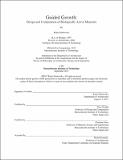Guided growth : design and computation of biologically active materials
Author(s)
Zolotovsky, Katia
DownloadFull printable version (11.41Mb)
Other Contributors
Massachusetts Institute of Technology. Department of Architecture.
Advisor
Terry Knight and Christine Ortiz.
Terms of use
Metadata
Show full item recordAbstract
In this dissertation, I propose ways for designers and architects to engage with the material units of biological computation and fabrication, namely the living cells. Microscopic cells, the basic units of life, are bits of material with embedded computation, fabrication, and regulation mechanisms. Their genetic code in the DNA performs complex computations, allowing cells to grow, interact with their environment through exchange of matter and energy, and even produce structural materials such as cellulose. These materials are renewable, self-assembling, self-healing, and biologically active. Our rapidly growing ability to re-program living cells to produce materials they would not produce in their natural state presents future possibilities as far-reaching as growing houses from seeds. This dissertation explores synthetic biology as a computational method to program cells so as to grow biologically active materials for architecture, with the possibility of designing them for new functions, including air filtering and purification, self-repair, and photosynthesis. To realize the potential for biologically active materials, I propose a Guided Growth design process, using the cellulose-producing bacterium Gluconacetobacter xylinus as an example. The Guided Growth design process employs three scales of resolution: nano (engineered living cells), meso (biomaterials that inhabit cells), and macro (bio-computational interface): · Nano-scale, the nanometer scale of DNA design: using tools of synthetic biology, I program the behavior of bacterial cells to respond to changes in their environment and pattern their function and properties. · Meso-scale, the micro- to centimeter scale of guided material self-assembly: using tools of materials science, I develop workflows to grow, shape, harvest, and process living-non-living composite biofilms, while keeping the bacteria cells alive and biologically active. · Macro-scale, the centimeter and up scale of bio-computational interface: using tools of digital fabrication, I design and fabricate a bio-computational interface that through computationally regulated flow of nutrients, added substances, and air allows the designer to interact with the process of growth. In the Guided Growth design process, I collaborate with synthetic biologists and computational designers to integrate the rigor of scientific research and the openness of material-based explorations. This multiscale collaborative process can be further generalized to other material systems where programmed living cells act as matter-organizing agents. My experimental methodology proposes new ways of computational making in architecture, a new class of biologically active materials, and a new application domain for synthetic biology.
Description
Thesis: Ph. D. in Architecture: Design and Computation, Massachusetts Institute of Technology, Department of Architecture, 2017. This electronic version was submitted by the student author. The certified thesis is available in the Institute Archives and Special Collections. Cataloged from student-submitted PDF version of thesis. Includes bibliographical references (pages 122-129).
Date issued
2017Department
Massachusetts Institute of Technology. Department of ArchitecturePublisher
Massachusetts Institute of Technology
Keywords
Architecture.